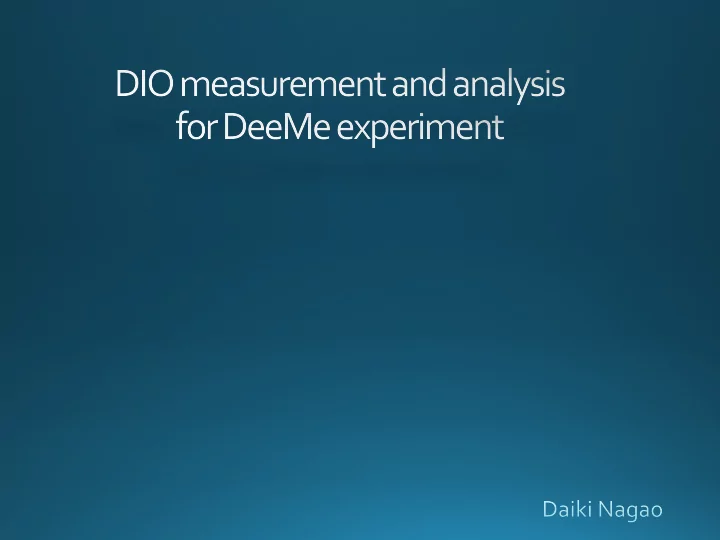

Proton μ - Production ② ① high-P low-P BG e - e - Signal π - Spectrometer Magnet ④ μ-e Conversion ③ Muonic Atom Formation ② in-flight π - → μ - ① π - Production Secondary Beamline Target signal electron is… • single ③ ④ • mono energetic • delayed The signal electron is identified by their momentum and time information Start with Carbon target • Lifetime of muonic atom ~ 2 μs • Energy of electron from � -e conversion = 105 MeV Single event sensitivity (1 year = 2×10 % sec) • 1×10 &'( • In case of SiC… 2.5×10 &'+ (4 years) • 2×10 &'+ • 5×10 &', (4years) •
μ-e conversion searching experiment at J-PARC MLF H-Line Experimental groups are working to complete H-Line with the facility group. MLF Muon facility H1: DeeMe experimental hall Proton Beam
Counts (/0.2MeV/c) 2 10 DIO signal region 10 1 ) -e conversion -1 10 • Decay In Orbit 0.015 (event/year) -2 10 • Distinguished by momentum -3 10 Delayed proton prompt background < 2.9×10 '( (event/year) • -4 10 (zero in principle) 90 95 100 105 110 115 120 • Momentum (MeV/c) Distinguished by time distribution Primary Proton • Delayed protons from main pulse are from RCS Delayed proton monitored by a beam loss monitor in RCS No proton • Cosmic-ray induced // e: <0.018, ) : <0.001 (event/year) Measurement • suppressed by duty factor(= 1/20000) time window and horizontal tracking direction • Anti-Proton Zero in principle e - signals // • beam energy(=3 GeV) at detector < * p production threshold Prompt electrons from delayed proton
OFF ON Anode wire: 1450V Anode wire: 1450V Potential wire: 1450V Potential wire: 0V Gas gain: O(10 4 ) Gas gain: O(1) efficiency ~98% in Publication: PTEP, Volume switching-ON period 2017, Issue 2, 023C01
Watanabe spectrum Beamtime had been held in MLF D-line • Performance test of spectrometer system • DAQ test with 4 MWPCs • Development of tracking analysis codes with real data • DIO spectrum analysis • Confirmation of Czarnecki C spectrum
• 2�5,����430��/�F�HA • 1�F�HA�P=L�H�M�=�=�F=�FA • 4A=L��A�AHM�AHA�CR���))�4A� • 9DA��AJAH�AH�A��H����=H��A�LAAH�=M�))�4A� �AM�J • -A=� • ���4A�����A�=R����H • 9=�CAM • ��CDM�HAQM�M��MDA��A=��P�H��P • ()T=H����T=C=�HLM�M���A=��=Q�L�=H�� �=CHAM�=Q�L Magnet axis • �JA�M���AMA� Beam axis • 0�FF�4�5��LAM�=H��LA�M����AH��HC��=CHAM • 9��CCA��=H��/,� • 9��CCA���B�/,��LRH�D��H�SA��P�MD�MD=M��B�=��AFA�=M����M��CCA�A��A�A�R�(���L • �=�AB�����A����A���R��� ���D����41S�0F=LD�,/�
#ch@X time (10ns) #ch@Y 1. test pulse 2. HV-switching OFF->ON 3. over shoot by PZC circuit 4. signal 5. HV-switching ON->OFF time (10ns) A template waveform is a set of most frequent value in each sample points
120 100 compared the shape of measured momentum 80 spectrum with MC simulation 60 40 20 Michel spectrum (calculation) 0 0.03 0.035 0.04 0.045 0.05 0.055 0.06 0.065 0.07 0.075 0.08 GeV 30 25 MeV 20 15 Momentum spectra of data are consistent to that 10 of MC 5 Calibrated with MC spectrum 0 0.03 0.035 0.04 0.045 0.05 0.055 0.06 0.065 0.07 0.075 0.08 GeV
MWPC laser !" Magnet ��� 2 axis ��� 1 !" When !" = 0.1 '' the errors of each MWPC are WC0: 0.35 mm WC1: 0.22 mm WC2: 0.19 mm WC3: 0.31 mm
(Momentum spectrum with moved MWPC) a(dx) and b(dx) fitting with liner function (Momentum spectrum with original position) a(dx) b(dx) cm cm cm GeV/c fitting with liner function in Iteration for MWPC 1-4 40~50MeV/c region 9 : = < : − 0.045 + C
����������� @mu+ 45 MeV/c) ������� at 50MeV/c a relative statistical error=14% relative systematic error=1.4% Calculate pdf of a in possible dx region GeV/c Calculate momentum distribution of -> the systematic error is smaller than statistical error
DIO Momentum spectrum acceptance curve @ 55MeV/c Measured momentum spectrum @55 MeV/c DIO momentum spectrum can be calculated as (Measured DIO momentum spectrum) / (acceptance curve) Acceptance curve is generated by MC simulation with flat momentum gun file
DIO spectrum normalizing 0.5 MLF 201706 run6355-6419 region MC Watanabe-O MC Watanabe-C (Uesaka-C) 0.4 MC Czarnecki-C 0.3 0.2 0.1 0 48 50 52 54 56 58 60 MeV/c • Each spectrum normalized in the normalizing region • The measured spectrum and each MC spectrum are compared in the comparison region
DIO spectrum normalizing 0.5 MLF 201706 run6355-6419 region MC Watanabe-O MC Watanabe-C (Uesaka-C) 0.4 MC Czarnecki-C 0.3 comparison region 0.2 0.1 0 48 50 52 54 56 58 60 MeV/c fit measured spectrum with each MC spectrum • Each spectrum normalized in the Watanabe-O : prob. = 21.5% normalizing region Czarnecki-C : prob. = 92.9% • The measured spectrum and each MC Watanabe-C : prob. = 43.7% spectrum are compared in the comparison region
Recommend
More recommend